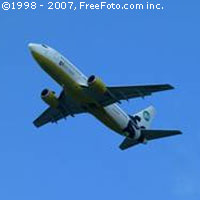Clean skies JTI takes off at Paris air show
The proposed 'Clean Skies' Joint Technology Initiative (JTI) for greener aviation was presented by European Research Commissioner Janez Potocnik during the International Paris Air Show on 20 June. The goal of the initiative is to improve the environmental performance and competitiveness of Europe's aeronautics industry. Concretely, its objectives are to reduce carbon dioxide (CO2) emissions by 40%, nitrogen oxide (NOx) by 60% and noise by 50%. It is hoped that these advances will be made in time for a major fleet renewal in 2015. The project is a public-private partnership, bringing together over 100 organisations including all the major aeronautical players in Europe as well as SMEs (small to medium sized enterprises), research centres and universities. The European Commission will provide €800 million in funding from the Seventh Framework Programme (FP7), and industry is expected to match this amount. 'European Commission studies show that the aviation industry accounts for 4% of annual greenhouse gas emissions,' commented Commissioner Potocnik. 'So, I warmly welcome industry's commitment to the Clean Sky initiative. Clean Sky will make the best use of both public and private resources to develop cleaner and quieter aircraft, with spill-over benefits in many other areas of science like materials, computer simulations, and energy management.' Within the proposed JTI, groups called Integrated Technology Demonstrators (ITDs) will carry out preliminary studies and then large-scale demonstrations in six key areas in order to develop innovative technologies to the level where they can be applied to the next generation of aircraft. The SMART fixed wing aircraft ITD will develop active wing technologies that sense airflow and adapt their shape as needed, while the Green Regional Aircraft ITD will focus on low-weight configurations and technologies, as well as the integration of technology developed in other ITDs. Developing innovative rotor blades and decreasing airframe drag are among the priorities for the Green Rotorcraft ITD. Meanwhile the Sustainable and Green Engine ITD will work on technologies aimed at lowering noise levels, decreasing NOx emissions and improving efficiency. The Systems for Green Operations ITD will focus on aircraft equipment and systems architectures, capabilities for 'green' trajectories and improved ground operations. Finally the Eco-Design ITD will address the full life cycle of material and components, with an emphasis on optimising the use of raw materials, and decreasing the usage of natural resources and energy. A technology evaluator will be responsible for assessing the contribution of the six ITDs to the overall environmental objectives of the project. The Clean Skies JTI will be overseen by an executive board and an executive office. The board will be made up of representatives of the Commission and founding members of the JTI, such as leading players in the aeronautics industry and research centres. The executive office will be headed by a joint undertaking director and the ITD steering committees. The Clean Skies JTI is the third such initiative to be put forward by the Commission. Back in May it adopted proposals for ARTEMIS, a JTI on embedded systems technology, and the Innovative Medicines Initiative. Other candidate fields for JTIs are nano-electronics and hydrogen and fuel cells.



